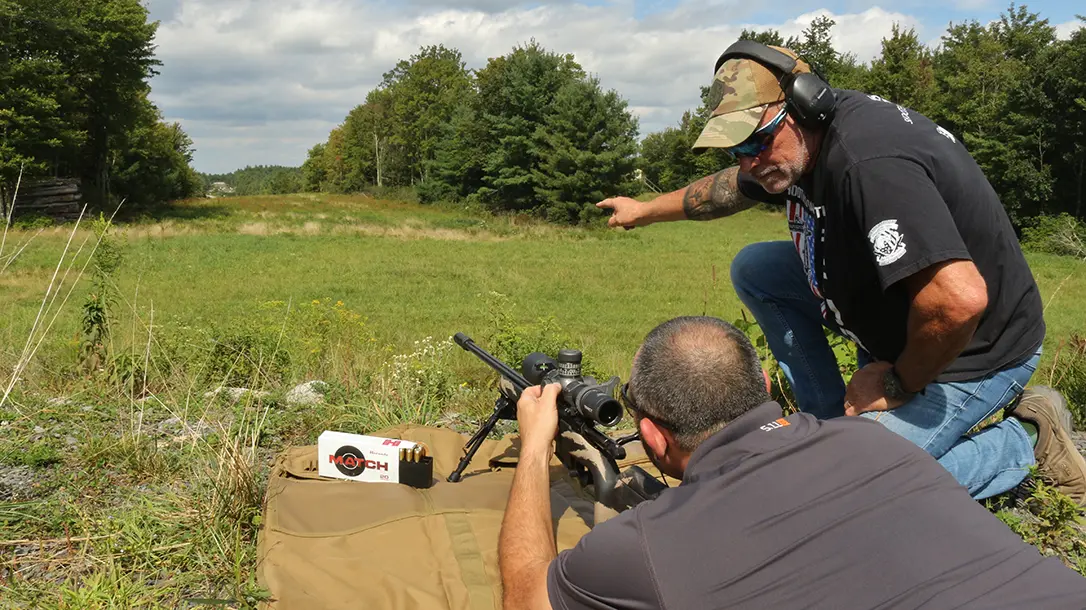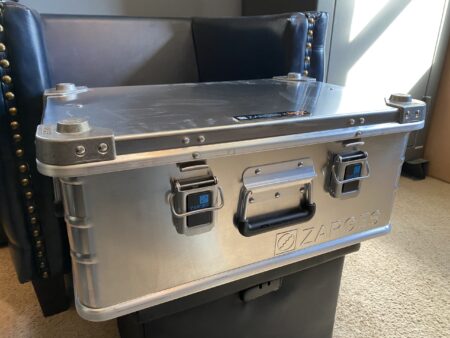About ten years ago, long-range shooting experienced a historic boom, prompting nearly every manufacturer to create scopes intended for targets at 1,000 yards and beyond. While this was excellent for my shooting and instruction career, it made writing more challenging. It was becoming increasingly difficult to get excited about what felt like a continual stream of identical products. After about 40 optics articles, I told myself it was time for a break, as I was repeating the same words too often. Then the Tract Toric Eagleman LR Hunting Scope ended my hiatus.
Tract Toric Eagleman LR Hunting Scope
Yes, I could write this introduction for nearly any optic and just change the last line, but Tract genuinely did something different here. First, it’s a return to the classic MOA system. I say “return” because leagues like the PRS have overshadowed the optics industry with their preference for mil-based reticles. While there’s nothing wrong with that system, this trend nearly halted the introduction of new MOA-based models for long-distance shooting.
Additionally, the reticle sits in the first focal plane, allowing ranging at any power setting. This combination is rare and excellent for teaching new shooters or helping experienced hunters harvest that previously out-of-reach trophy. While you can do this with a mil-based scope, MOA has a straightforward 1:1 ratio (one inch per 100 yards), making it easier for those using the English system to determine a hold based on a known measurement. The same applies to determining target distance based on size. We call this process mil-ing, but I can tell you firsthand the math is far simpler in the MOA scale.
Tract History
A little backstory on Tract is in order. The company is easy to support, as it was founded by two men living the American Dream. Just over nine years ago, Jon LaCorte and Jon Allen were dissatisfied with decisions made by the major optics company they worked for. With several decades of collective experience, they believed they could do better by removing corporate constraints. Both Jons were active firearms owners who spent significant time on the range and afield each year. As such, they attend several events and get input from some of the most significant instructors in the industry, like James Eagleman of Barbour Creek Shooting School.
James’ school focuses heavily on real-world hunting applications, and his students needed a scope to help teach that. From the collective input of both himself and his students, the Toric 4-25x Eagleman was born. One of the key features of this scope is the illuminated reticle with half-MOA windage subtensions and clearly marked directions instructing the shooter how to hold in a crosswind. This is paired with an exposed locking elevation turret adorned with excessively large numbers. Given that the most important hunting shots often occur in low-light conditions, this ensures you dial the correct DOPE and is easier on aging eyes. Built on a 34mm main tube, the Eagleman boasts more than 160 MOA of elevation adjustment, allowing your rifle to reach absurd distances even without canted hardware.

Optic Details
Each scope includes a removable zero-stop to help you avoid getting lost in all that adjustment. Some mistake this tube diameter as a design for better light transmission, but that’s not true. The Toric’s best-in-class light transmission comes from using uncompromising Schott HT glass and its generous 50mm objective lens. This optical system excels in low light and can “cut through” mirage on sweltering summer days.
Interestingly enough, Jon LaCorte and I hail from the same area and have spent many days together on the range in our native Suffolk County, NY. As life behind enemy lines doesn’t offer many opportunities to reach out, we’d often retreat to our respective long-range escapes in neighboring Pennsylvania. After getting a sneak peek at the Eagleman at the Great American Outdoors Show, Jon offered me the chance to be the first writer to test it at his preferred range, Shooter’s Gauntlet, in Monroeton, PA. Shooter’s Gauntlet is an interesting place, as it, too, was started by a Long Islander who had just about enough.
Here, Bob Raimo and his team of highly experienced instructors teach several scenario-based courses, long-range shooting, and survival skills. However, nothing gains the attention of their semi-annual machine gun shoot. The compound spans nearly 1,100 acres and includes several ranges that stretch out close to a mile. On this day, the three of us would have the entire place to ourselves–you can guess my answer. So, with a handshake, a pair of Eaglemans were on their way.

Going Long
With distances approaching a mile, I knew I needed to bring a heavy hitter. In my safe sat an Aero Precision Solus Hunter that hadn’t seen enough range time. This particular rifle was chambered in 6.5 PRC, and from my experience at the Athlon Outdoors Rendezvous, I knew it was a hammer out to at least a mile. With an entire case of Hornady’s 147-grain MATCH ammo on the menu, I capped it off with an American Precision Arms Fat Bastard muzzle brake to tame its kick and keep the reticle on target under recoil. I paired this with a trusty Springfield Waypoint chambered in 6.5 Creedmoor and stocked up on the 140-grain Hornady MATCH load it preferred. Tract offers color-matched rings from both MDT and Warne, so I used a pair from each company to position each scope to my liking.
The morning finally came when it was time to journey up the mountain to Shooter’s Gauntlet. With a three-hour drive ahead of me, I got up a bit earlier, leaving me groggy and under-caffeinated. To that effect, I stumbled in my driveway and sent my gun case straight to the ground, with both units landing flat on their elevation turrets. Calling it a “case” is pretty generous, as in reality, it’s just a shooting mat with a pair of rifles rolled up within. This left nothing but a thin layer of polyester between the scopes and the asphalt. I’m not quite a “torture-test” style writer, but this piece can now be classified as such.

Field Time
When I arrived at Shooter’s Gauntlet, I gave Jon the news, but he didn’t seem too concerned, as the optics are built of first-rate materials and designed for real-life incidents like that. Joined nearly immediately by Bob and his lead instructor, Justin Vititoe, the four of us set up the hill to Charlie Range, perhaps to visit its slightly longer brother, Delta, later in the day.
We settled our gear on a cozy shooting bench, zeroed the rifles, and punched a few groups for effect. As expected, the precision was there for long-range work, with some groups measuring as small as a ¼ MOA. After resetting the elevation caps, I had 101 MOA left on the Aero PRC and 84 MOA left on the Springfield Creedmoor, more than enough to send each round out to its effective range. With the rifles ready, I built a hasty range card for the Creedmoor based on a similar rifle and input real values into Hornady’s 4DOF calculator for the PRC. Bob’s range is realistic, with targets at irregular distances, just as animals don’t appear at perfect 100-yard increments.

Stretching the Distance
I started by running the Creedmoor through an array of eight targets ranging from 411 to 1,226 yards. As we were roughing our come-ups, it took a few rounds to score an impact, giving me a chance to test the glass quality, which was impressive. The 839-yard engagement summarized the experience best, as I could see a single leaf flicker from my bullet while my spotter, using a competitor’s spotting scope of far higher magnification, could not. The real world doesn’t always provide a highly reactive backstop, so many times, you need to pick up these faint impacts to correct and reengage. I ended my day with the Creedmoor at 1,226 yards, using only about half my available adjustment, easily satisfying the Eagleman’s claim to long-range utility.
Switching to the 6.5 PRC, I scored first-round hits all the way out to 1,226 yards without effort. This told me two things: Hornady’s app is spot on, and the Eagleman tracks flawlessly. With just a 3-5 MPH breeze, it was all too easy, leaving me eager for a longer shot. Bob mentioned they had a platform on Delta where we could stretch to 1,485 yards, so I immediately started packing. When we arrived, the sun was beating down, so we worked quickly.

Dialing the Toric Eagleman LR
Directing me to the target, I dialed up, estimated wind, and landed just 2 MOA to the right. Once we determined the impact, I corrected and put six consecutive shots on the 36×36-inch AR500 plate. During this volley, I fine-tuned my hits by adjusting the wind hold by just ½ MOA, which is more than seven inches at this distance. For those who consider this scale too fine, I’ll gently direct them to engagements like this, where one tick can be the difference between a successful hunt or a multi-day track of a wounded animal.
After a few more rounds, we spun both rifles back to their 100-yard zero and fired a group, confirming a crisp return. Scopes that fail this test are useless for long-range applications, so with that the three of us were satisfied and sought shelter from the heat. The Toric Eagleman delivered on its promise and even revealed some unsung features. One of them was the soft-touch knobs and magnification ring. Too often, these are so stiff that adjusting them is enough to knock you off target. Additionally, everything was dead quiet, a critical feature when engaging something within earshot.

Other key features were the scope’s length and price point. At just 13.5 inches, it’s on par with many of my 4-16x optics while offering nearly twice the zoom. You’d think this would cost an arm and a leg, but Tract’s direct-to-consumer business model cuts out several middlemen, yielding a list price of only $1,494—not bad for a scope that can cut through nearly a mile of mirage, even after being dropped turret-down on concrete. Tract offers an undisputed lifetime warranty, but as I’ve demonstrated, you’ll likely never need it. For more information on Tract Optics or Shooter’s Gauntlet, visit them at tractoptics.com or shootersgauntlet.com.
Bonus Gear: APA Fat Bastard Brake

Taming recoil is more than just cutting the kick. Magnum rifles tend to knock you off target when you pull the trigger, making it tough to spot where your bullet lands. When that happens, you won’t know if you scored a first-round hit or need to reengage. The American Precision Arms Fat Bastard Brake is built not only to save your shoulder but also to keep your muzzle flat during a string of fire. Atop each brake are ten tuning ports that can be opened or closed with the provided hardware to adjust it perfectly to your specific rifle and load. These are exceptional for competitive shooting, hunting, or just enjoying a smoother experience on the range. (americanprecisionarms.com)
Tract Toric Eagleman LR Hunting Scope Specs
- Magnification: 4-25x
- Objective Lens Diameter: 50mm
- Eye Relief (inches): 3.6 – 3.8
- Exit Pupil: 12.5-2
- Field of View (Low Power/High Power in feet @ 100 yards): 29.2 / 4.7
- Length (inches): 13.5
- Weight (ounces): 36
- Elevation Adjustment Range (MOA): 160
- Click Value (MOA): .25 MOA
- Tube: 34mm (one piece)
- Reticle Type: Glass Etched MOA Eagleman LRH
- Coatings: Fully Multi-coated
- Illuminated Reticle Battery Type: CR2032
- Illumination Battery Life: 360 Hours at Medium Intensity
- Recoil Shock Endurance
- Parallax Setting: 15 yards to Infinity
- Reticle Focal Plane: 1st
- Waterproof Depth (meters): 3
- Country of Origin: Japan
Read the full article here












